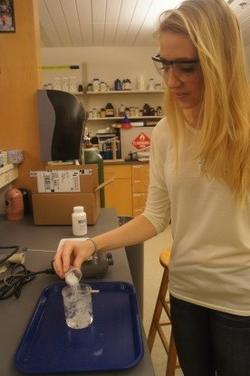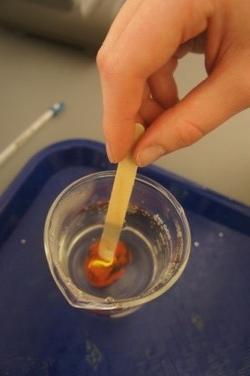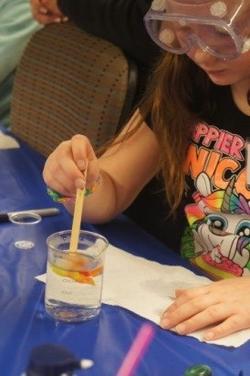When thermoplastic polymer became available a couple of years ago, we purchased a bottle to see if it would be a viable addition to our chemistry outreach program. Since then, literally hundreds of people, young and old, have experienced molding the thermoplastic, taking their creations home in Zip-loc® bags. And now, with the availability of dyes, a whole new world of creative design has opened up. The molding of a thermoplastic activity has been incorporated into our “Polymers” and “Chemistry of Crafts” hands-on outreach presentations, and has been used as a stand-alone station. Students enrolled in our Chemistry Outreach Service Learning course have employed the thermoplastic as part of their in-class group presentations. Recently, one group, as part of their holiday theme, had the class make ornaments to decorate the “chemistree,” inserting hooks while the plastic was still soft enough to hang them on the tree.
 The thermoplastic is inexpensive; one 250-gram bottle provides enough for twenty-five individuals. The dyes are also inexpensive and, since not much is needed to dye a sample, a little will go a long way. The activity is easy to do. It requires very little in the way of equipment. There is no waste and the thermoplastic can be reshaped again and again. All that is needed is hot water, a glass container and a metal spoon or wooden craft stick.
The thermoplastic is inexpensive; one 250-gram bottle provides enough for twenty-five individuals. The dyes are also inexpensive and, since not much is needed to dye a sample, a little will go a long way. The activity is easy to do. It requires very little in the way of equipment. There is no waste and the thermoplastic can be reshaped again and again. All that is needed is hot water, a glass container and a metal spoon or wooden craft stick.



Thermoplastics are a class of polymers that undergo a transition from a hard crystalline solid to a soft amorphous material when heated. The temperature at which this transformation occurs is referred to as the glass transition temperature Tg. The Tg for the thermoplastic we use is 60ºC. Students are familiar with thermoplastics, such as acrylic, nylon, polyethylene, polypropylene, polystyrene, polyvinyl chloride and Teflon®. Commercially, thermoplastics are employed in consumer goods, machine parts, medical equipment and storage materials.
Molding thermoplastics directions









